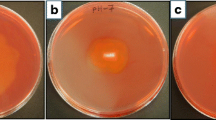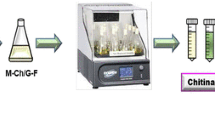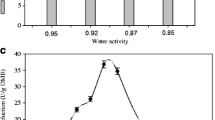Abstract
The production of hydrolytic enzymes by the mutant Trichoderma reesei Rut-C30 when cultivated in the presence of various carbon sources: glucose, wheat bran and autoclaved mycelium of Penicillium occitanis CT1 has been studied. Glucose was shown to repress all studied hydrolases, 3% of either wheat bran or autoclaved cell walls led to high titers of enzymes, and were favorably comparable to commercial lysing enzymes (LE). The lysing enzyme cocktail obtained when T. reesei Rut-C30 was cultivated in the presence of autoclaved P. occitanis CT1 mycelia appeared to be a most effective for P. occitanis CT1 protoplast formation. Maximal yield of protoplasts reached 13 × 106 protoplasts/mL while commercial LE preparation released only 4 × 106 protoplasts/mL. The protoplast yield was affected also by the osmotic stabilizer, with KCl giving the best results. Our results suggest that to achieve the best protoplastization rate, the enzyme preparation should be obtained following induction by the autoclaved mycelium of the autologous fungus.
Similar content being viewed by others
References
Fontaine, T., Simenel, C., Dubreucq, G., Adam, O., Delepierre, M., Lemoine, J., et al., J. Biol. Chem., 2000, vol. 275, no. 36, pp. 27594–27607.
Pessoni, R.A.B., Freshour, G., Figueiredo-Ribeiro, R.C.L., Hahn, M.G., and Braga, M.R., Mycologia, 2005, vol. 97, no. 2, pp. 304–311.
Leal, J. A., Gomez-Miranda, B., Prieto, A., Domenech, J., Ahrazem, O., and Bernabe, M., Mycol. Res., 1997, vol. 101, no. 10, pp. 1259–1264.
Santos, A., Marquina, D., Leal, J.A., and Peinado, J.M., Appl. Environ. Microbiol., 2000, vol. 66, no. 5, pp.1809–1813.
Saloheimo, A., Henrissat, B., Hoffrén, A.M., Teleman, O., and Penttilä, M., Mol. Microbiol., 1994, vol. 13, no. 2, pp. 219–228.
Kubicek, C.P., Messner, R., Gruber, F., Mach, R.L., and Kubicek-Pranz, E.M., Enzyme Microb. Tech., 1992, vol. 15, no. 2, pp. 90–99.
Lynd, L., Weimer, P.J., van Zyl, W.H., and Pretorius, I.S., Microbiol. Mol. Biol. Rev., 2002, vol. 66, no. 3, pp. 506–577.
Kubicek, C. P., Herrera-Estrella, A., Seidl-Seiboth, V., Martinez, D. A., Druzhinina, I. S., Thon, M., et al., Genome Biol., 2011, vol. 12, no. 4, p. R40.
Gruber, S G. and Seidl-Seiboth, V., Microbiology, 2012, vol. 158, no. 1, pp. 26–34.
Kakoniova, D., Labudova I., and Liskova, D., Biotechnol. Lett., 1987, vol. 9, no. 10, pp. 721–724.
Cocking, E.C., Nature, 1979, vol. 281, no. 5728, pp. 180–181.
Eveleigh, D.E. and Montenecourt, B.S., Adv. Appl. Microbiol., 1979, vol. 25, pt. 1, pp. 57–74.
Hadj-Taieb, N., Ayadi, M., Trigui, S., Bouabdallah, F., and Gargouri, A., Enzyme Microb. Technol., 2002, vol. 30, no. 5, pp. 662–666.
Mandels M., Weber J., and Parizek R., Appl Microbiol. 1971, vol. 21, no. 1, pp. 152–154.
Miller, G.L., Anal. Chem., 1959, vol. 31, no. 3, pp. 426–428.
Saibi, W., Abdeljalil, S., and Gargouri, A., World J. Microb. Biot., 2011, vol. 27, no. 8, pp. 1765–1774.
Cottrell, M. T., Wood, D. N., Yu, J. and Kirchman, D. L., Appl Environ. Microb., 2002, vol. 66, no. 10, pp. 1195–1201.
Bradford, M. M., Anal. Biochem., 1976, vol. 72, nos. 1–2, pp. 248–254.
Laemmli, U. K. and Favre, M., J. Mol. Biol., 1973, vol. 80, no.4, pp. 575–592.
De Vries, O.M.H. and Wessels, J.G.H., J. Gen. Microbiol., 1973, vol. 76, no. 1, pp. 319–330.
Lora, J.M., De la Cruz, J., Llobell, A., Benitez, T., and Pintor-Toro, J.A., Mol. Gen. Genet., 1995, vol. 274, no. 5, pp. 639–645.
Yang, H.H., Yang, S.L., Peng, K.C., and Liu, S.Y., Mycol. Res., 2009, vol. 113, pt. 9, pp. 924–932.
Abdeljalil, S., Ben Hmad, I., Saibi, W., Amouri, B., Maalej, W., Kaaniche, M., Appl. Biochem. Biotechnol., 2014, vol. 172, no. 3, pp. 1599–1611.
Hamlyn, P.F., Bradshaw, R.E., Mellon, F.M., Santiago, C.M., Wilson, J.M., and Peberdy, J.F., Enzyme Microb. Technol., 1981, vol. 3, no. 4, pp. 321–325.
Peberdy J.F., Fungal Protoplasts, Applications in Biochemistry and Genetics, Peberdy, J.F. and Ferenczy, L., Eds., New York: CRC Press, 1985, pp. 45–71.
Kumari, D.L., Ind. Phytopathol., 1996, vol. 49, no. 3, pp. 199–212.
Zhou X., Wei Y., Zhu H., Wang Z., Lin J., Liu L. and Tang K., Afr. J. Biotechnol., 2008, vol. 7, no. 12, pp. 2017–2024.
Author information
Authors and Affiliations
Corresponding author
Additional information
The article is published in the original.
Rights and permissions
About this article
Cite this article
Aloulou-Abdelkefi, M., Trigui-Lahiani, H. & Gargouri, A. Autoclaved mycelium induces efficiently the production of hydrolytic enzymes for protoplast preparation of autologous fungus. Appl Biochem Microbiol 53, 230–236 (2017). https://doi.org/10.1134/S000368381702003X
Received:
Published:
Issue Date:
DOI: https://doi.org/10.1134/S000368381702003X




